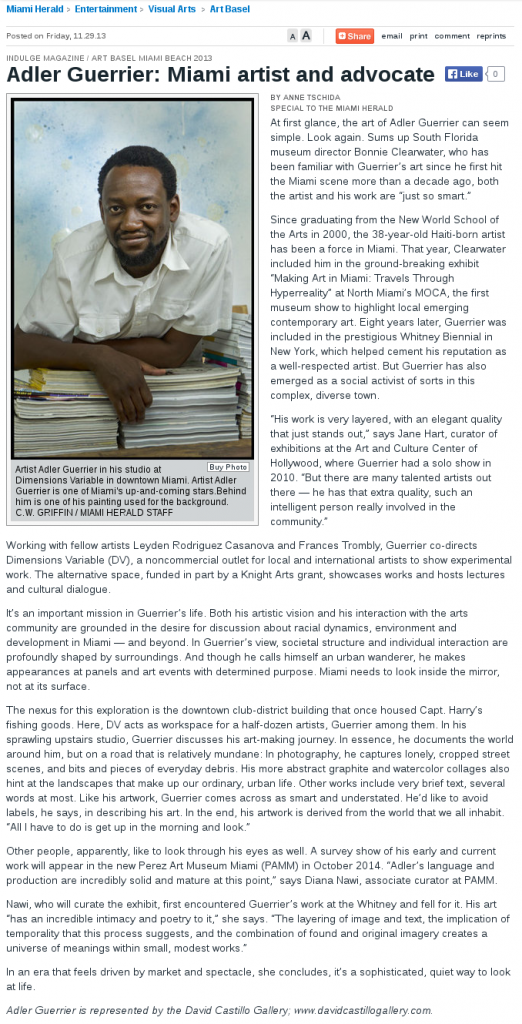Tawe, Elisha, “Adler Guerrier: Dreams and Geographies that Transfigure Us”, Contemporary And América Latina, July 12, 2023.
The city of Miami derives its name from the Mayaimi, a Native American tribe that lived around Lake Okeechobee until the 1760s when Britain took control of Florida. The Mayaimi lived off the lake, often surviving on fish alone during high water season. Today, stormwater pollution and algal blooms fueled by fertilizer runoff have transmuted Lake Okeechobee drainage canals into some of the United States’ most polluted. Colonialism constructed nations within a context of capitalist extraction, a formulation which disregarded how an Indigenous population may value a place. Under the shadowy control of capital, the multiple imaginaries within a location and their consequences on the language around a territory are overlooked. How can we harness the powers of enchantment to reconfigure our understandings of these geographies?
Haitian-born, Miami-based artist Adler Guerrier operates within a formative space of play he refers to in conversation as “the realm of the imaginary, of dreams.” A realm not dictated by the constraints of the one we corporally share. In this realm, history remains, but the rigor of conventional order does not. “For me, this is a fruitful realm,” he exclaims. “I use the word enchanted to describe it, a term I’ve borrowed from Toni Morrisons’ novel Tar Baby. In Tar Baby, a half-blind woman takes a character named Son to a place where no one lives to be influenced, in essence, by enchanted beings. This is an example of how dreams and geographies transfigure us. Folded in them is a space for an imaginary we can slide ourselves into. A realm in which green and yellow become more than green and yellow, as they carry some unknowns. Where a sweet melody becomes a vessel that can take us elsewhere.”
Surveying the artist’s studio through my screen as he maneuvers within it, I encounter works spanning various mediums. However, our conversation centers Field Guide – exposure to enchanted forms (2022), a collection of collage works grounded in photographic images of Haiti, Cuba and Miami. The works are set to be exhibited at the 23rd Bienal de Arte Paiz (July 13 – 30) in Guatemala, titled I drank words submerged in dreams – a line from Guatemalan poet Maya Cū’s Nací Mujer. This year’s biennale finds its footing in the practices of Margarita Azurdia, Ana Mendieta, Fina Miralles, Maria Terezha Negreiros, and Cecilia Vicuña. It delves into poetic, political and dreamlike territories in which materialities, subjectivities and desires take shape.
The themes of the biennale overlap with Guerrier’s understanding of geography as part of a larger discipline concerned with history, language and the body. One which reconsiders notions of state, accounting for community-level understandings and identifications of terrains. This view of geography intersects with fluid definitions of the field, considering diasporic language which often refers to an expanded notion of territory existing across multiple continents. “It’s just a reconstituted geography,” Guerrier affirms. “A reconstituted geography which for me lends itself to collage making. It’s about adjacency and juxtaposition, it’s a layout or arrangement of what you bring in your bag of remembrance.”
It’s just a reconstituted geography. A reconstituted geography which for me lends itself to collage making. It’s about adjacency and juxtaposition, it’s a layout or arrangement of what you bring in your bag of remembrance.
In Field Guide, Guerrier grapples with these launching points, exploring them through existing enchanted forms and diasporic language. The works consist of graphite, gouache, cut vinyl, enamel paint and Xerox Versant 80 print on Mohawk superfine paper. They feature a palette of 8 forms which recur across the artist’s oeuvre. “What I like about using these molecular structures, these clustered forms, is the likelihood of me making the same work twice is quite low because the permutations of putting eight things together are quite high. This is a richness of this language of conjugated forms; it hints at possibilities for newness and at complexities derived from a vernacular proper to this reconstituted geography.”
A palette of colors also recurs across the works. Here repetition takes on a metaphysical quality alluding to the artist’s memories of familial gatherings and the storytelling associated with them. “There’s a formalness that sometimes an utterance takes, and that certain form can become precious,” he says. “The yard of my parent’s house has been a place to talk about the present and a lot of the past. A past that is sometimes set in rural Haiti, in our reality of Miami and in other temporal points in between. As members of a diaspora, multiple really, stories are part of our inheritance. They form a knowledge that is embodied and makes us feel more complete. When we travel back to our home countries, we collect fragments and return with a bit more knowledge that is mostly expressed through language. This is one way language appears in my works. It’s a reach for points on a map and in a shared psychic space that I arrange to be closer.”
Field Guide can be understood as an unnamed and unembodied person, a set of configurations which hint at an unconscious familiarity and a guide for enchanted Indigenous and diasporic poetic knowledges. A sense of transnational oneness percolates through these works, a oneness rooted in an understanding of the contemporary and historical complexities of geography.
Adler Guerrier is a Haitian-born, Miami-based artist. He calls upon the democratizing nature of collage to explore constructions of race, class and culture across time. Guerrier received a BFA at the New World School of the Arts.
Elisha Tawe is a writer, filmmaker and co-founder of the creative duo GRAY417C. He is currently based in London. Instagram.
